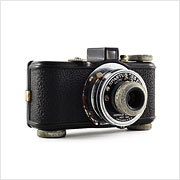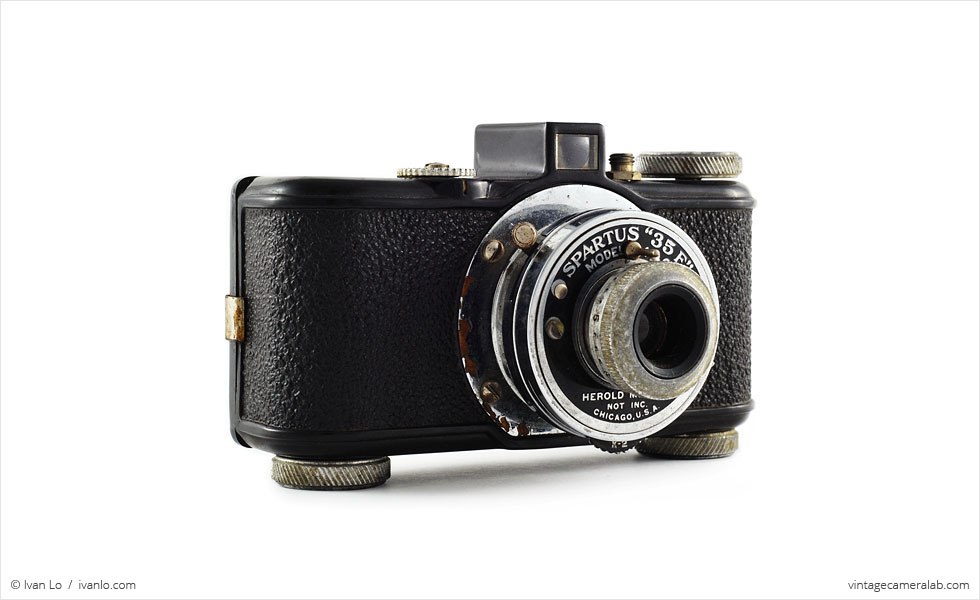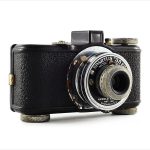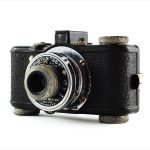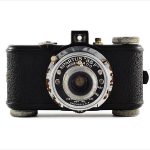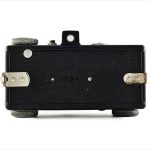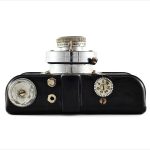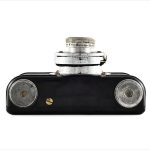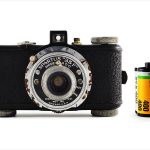Spartus 35F Specifications
| Manufacturer: | Spartus Camera Corp. |
| Origin: | USA |
| Made in: | Chicago, IL, USA |
| Introduced: | 1947 |
| Type: | Viewfinder |
| Format: | 135 Film |
| Dimensions: | 12.7 x 8 x 6.8 cm |
Spartus 35F Overview
The Spartus 35F and its twin, the Spartus 35 are simple 35mm cameras made of Bakelite, an early plastic. Modeled after the highly successful and massively influential Argus A, the 35F features a classic shape very common to 35mm cameras of its era. The 35F was manufactured in Chicago by the aptly named Spartus Corp. before it became the Herold Manufacturing Co. which is why the lens of this particular specimen bears the Herold name. Spartus Corp. and its incarnations produced a great multitude of Bakelite cameras (many of which are practically identical to each other) under a wide variety of different brand names such as Utility, Falcon, Monarch and, of course, Spartus.
The 35F features a very basic 50mm lens with a minimum focus distance of four feet. Aperture is controlled by rotating a metal plate behind the lens which have precut holes for f/7.7, f/11, and f/16 as well as a second f/7.7 hole with an integrated K2 (yellow) filter. The shutter is preset at 1/50 seconds but can be put on “time” mode by adjusting a small dial on the lens barrel opposite the shutter lever. However, “time” mode doesn’t mean “time” in terms of shutter speed (first press of the shutter locks it open, the second press closes it again) but actually means “bulb” (shutter stays open only as long as button is pressed).
On the top left of the camera is the rewind knob that can only be activated by pressing the silver button on the back. Then to the right is a threaded flash sync socket which puts the “F” in “35F.” In the middle is the simple optical viewfinder and to the right of that is the frame counter. Like many cameras of its day, the back comes off completely (as opposed to being hinged) and comes undone by lifting the metal tab on the left. The film advance knob can be found on the bottom of the camera opposite the tripod socket.
As a proud Chicagoan, I have a soft spot for cameras produced in this great city and I hunt for them whenever I can. This particular 35F was purchased from a thrift store for around $10. By contrast, the Spartus originally retailed for $12.50 (about $130 in today’s money). The chrome plating has begun flaking off around the lens and the barrel is slightly crooked (probably from a previous owner dropping it) but I prefer my cameras with a little character.
Find your very own Spartus 35F on eBay.
McKeown, James M. and Joan C. McKeown’s Price Guide to Antique and Classic Cameras, 2001-2002. (Grantsburg, WI, USA: Centennial Photo Service, 2001), p 619.
